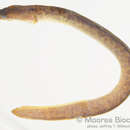The family Anguillidae contains 15 species and 3 subspecies of freshwater eels, all in genus
Anguilla. Freshwater eels are found in most tropical and subtropical areas of the world except the east coast of South America, and the unique distribution of eels has been a subject of many biogeography studies to explain their dispersal (Aoyama et al., 1996, 2001; Aoyama and Tsukamoto, 1997; Bastrop et al., 2000; Lehmann et al., 2000; Lin et al., 2001; Tagliavini et al., 1995, 1996; Tsukamoto and Aoyama, 1998). Anguillid eels are catadromous, meaning that they spawn in the ocean, where the new hatchlings (called leptocephalous larvae) eat small particles of plankton and diatoms, but once they grow larger (the glass eel stage), ocean currents carry them to freshwater and estuarine habitats where they live most of their lives, eating a carnivorous diet of fish, invertebrates, and amphibians. Freshwater eels are long-lived, one European eel (
A. Anguilla) has been recorded as living for 88 years in captivity. Their life histories are interesting and complicated; leptocephalous larvae were long classified as separate species and even now while adult-larval pairs are match up, much of their life histories is still unknown. Fossil evidence indicates that this family radiated between 100 and 50 million years ago, and recent molecular analyses suggests that they radiated in three groups: an Atlantic group of two species, Oceanic group of three species, and an Indo-Pacific group of 11 species. Freshwater eels are important food fish and have been farmed for centuries. Unagi (the Japanese word for freshwater eel) is a common Japanese meal, and one of the top four types of sushi in the US. Three species are commonly eaten: the Japanese eel
Anguilla japonica, the European eel,
A. Anguilla and
A. rostrata, the American eel and have all suffered extreme population declines from habitat loss, dam construction preventing their migrations, pollution, and overfishing. The Monterey Bay aquarium recommends consumption of freshwater eels as it is an unsustainable fishery. Even though most freshwater eel supplied for eating is farmed (in China), these eel are not bred in captivity, but are instead captured at the glass eel stage and as such put more pressure on eel populations. (
Froese and Pauley 2011;
Halpin 2007;
US Fish and Wildlife Service Newsroom, 2011;
Wikipedia 2011)

